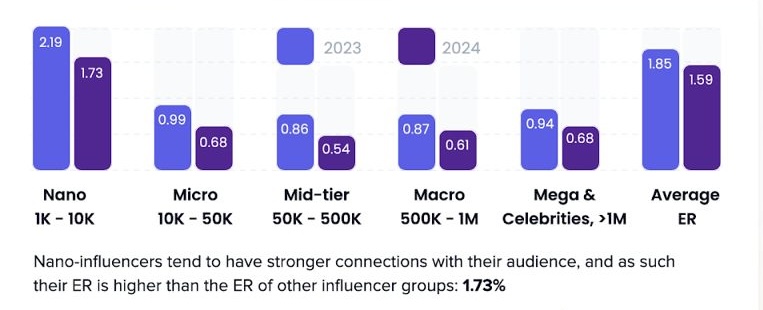Meta Title:
Top of Influencer Marketing strategies in 2025 | Past, Present & Future
Meta Description:
Discover how influencer marketing has evolved into a $31B industry in 2025. Explore key trends on Instagram, TikTok & YouTube, the rise of nano-influencers, AI-driven strategies, and what brands must do now to win with authentic connections.

Brands are spending more on influencer marketing (IM Report, Hypeauditor 2024).
And many are involving trustworthy contents and AI-blends to amplify their marketing success.
“How much are you spending or willing to spend on influencer marketing?” should be one of the top three questions every brand should ask themselves when reviewing and here is why.
Take a dive of the report curated from IM Report and our winning strategy on how you can engage this marketing gold.
Telling Your Brand
A few years ago, influencer marketing was brushed off as a fad. It would always be images of glossy Instagram feeds, image banks of the too-perfect coffee shots, matching glasses and dresses with mega-celebrities who seemed more distant than relatable. It is 2025, and the story has changed. Influencer campaigns are no longer just about visibility. It is about ROI, conversions, and measurable sales impact. However this change started a little earlier than this year with what once an experiment now matured into a $19.8 billion as at 2023 global industry, and on track to hit $31.2 billion, fueled by accelerated adoption and technological advancements.
The 2025 HypeAuditor Industry Report reads less like a set of statistics and more like a futuristic story about a movement that is now powered by trust, data, and AI. The report revealed that in 2024, global ad spend crossed the $1 trillion mark. Although the influencer market’s share was under 2%, its growth trajectory soon steeper far than most other segments and the numbers became the shift in how brands think.
Even more striking? Micro- and nano-influencers are leading the charge. Over 64% of marketers worked with them in 2024, citing higher engagement rates and authenticity. For smaller brands especially, sponsored posts, affiliate deals, and user-generated content are proving more cost-effective than many traditional ads. The democratization of tools and AI-powered analytics has leveled the playing field, making influencer marketing accessible in ways it was not five years ago.

Instagram: The Storyteller’s Playground
If influencer marketing had a capital city, it would still be Instagram. With 2.1 billion monthly users, nearly half between ages 25–34, Instagram dominates the space.
The reason is clear. About 87% of users take action after seeing product information on Instagram and that “action” could be following a brand, checking a website, or buying something directly. As long as this message is personal. On instagram, the most effective creators are the nano-influencers. Their audiences might be small, but they make 76% of the creators with engagement rates that are deeply personal. Nano-influencers consistently outperform mega-creators, building community over celebrity.
Worthy to note, Instagram is evolving. In 2024, the platform prioritized Reels, introduced AI-generated content features, filtered DMs for brand partnerships, and cleaned up inactive followers. These updates made influencer collaborations sharper and more authentic. Brands like Zara, Nike, H&M, SHEIN, and Amazon ensured to take advantage of blending fast fashion, retail, and lifestyle with social-first storytelling.
Influencer marketing is changing the gaming world. Read about how we helped a top class gaming brand win with unique influencer marketing strategy here
TikTok: The Trend Factory
TikTok is another cultural newsfeed. With 1.6 billion monthly users, more than half under 24 and 56% female, it’s the beating heart of Gen Z consumer culture. The report highlights TikTok’s strength are the nano- and micro-influencers with average engagement rates of 10–12%, far outpacing other platforms. TikTok is becoming a commerce hub as much as a content platform. TikTok Shop exploded in 2024, hitting $100M in sales on Black Friday alone. Combined with the rise of mini apps like food ordering and ticketing. Yet, its future carries uncertainty. A looming U.S. ban deadline in early 2025 has brands diversifying across platforms as a safeguard. Still, TikTok’s power to create overnight trends from the beauty hacks to viral recipes remains unmatched.
YouTube: The Deep Diver
Where Instagram is quick and TikTok is viral, YouTube is steady and evergreen. With 2.7 billion monthly users, 64% aged 18–34, it remains the second-largest search engine in the world. This permanence is YouTube’s advantage. A video uploaded today can still attract views and drive sales years later. That longevity makes it a trusted platform for tutorials, reviews, and deep-dive storytelling.
In 2024, YouTube rolled out AI auto-dubbing (helping creators reach global audiences), shoppable Shorts, and a new Hype feature that boosts emerging creators. Also, the Youtube Shorts is closing the gap on TikTok to becoming the place where entertainment, education, and shopping intersect. Together, these tools make YouTube both a launchpad for newcomers and a revenue engine for established influencers.
The People Behind the Platforms
One thread ties Instagram, TikTok, and YouTube together: the power of community. On Instagram, young adults (especially women 25–34) drive conversations around fashion and lifestyle. On YouTube, men in the 18–34 range dominate, though younger women are increasingly visible. On TikTok, Gen Z rules, making it the best place for youth-focused brands.
Across all platforms, short-form video reigns supreme. Reels, Shorts, and TikToks outperform static content in reach, engagement, and conversions.
The Hole in the System: Engagement and Fraud
But even as influencer marketing matures, challenges remain. Engagement rates overall are declining, especially for larger creators. The report notes that brand accounts on Instagram average just 0.5% ER, compared to higher rates for influencers. Fraud also persists. While the percentage of accounts impacted dropped from 49% in 2021 to 42.7% in 2024, that’s still nearly half the industry. Fake followers, purchased likes, and engagement pods continue to cost brands millions.
What this means for us is that numbers alone can mislead. Brands must look beyond follower counts to measure real engagement and authenticity.
The Next Chapter: AI & Community
Looking ahead, there are two megatrends shaping influencer marketing’s future: AI and creator-led communities.
AI will power influencer discovery, predict campaign results, and localize content seamlessly. Communities will replace audiences. Influencers are moving toward building memberships, groups, and exclusive experiences where loyalty not just reaches drive revenue.
We will also see a rise in niche influencers, virtual influencers, and creator-led product lines. Social commerce will become the norm, with live shopping and shoppable videos integrated everywhere.
What Brands Should Do Now!
1. Prioritize ROI over vanity metrics. Likes do not pay the bills, let sales do.
2. Go small to win big: Partner with nano- and micro-influencers for cost-effective engagement.
3. Be native: Use Reels, Shorts, and TikTok videos for maximum impact.
4. Diversify platforms: Do not bet everything on TikTok or Instagram. Spread the risk.
5. Stay fraud-aware. Vet influencers and invest in analytics.
6. Adopt AI early. It’s the new competitive advantage.
The influencer marketing industry has grown up. From its messy, hype-driven beginnings, it has matured into a data-informed, ROI-focused, and trust-powered ecosystem.
Instagram still leads in reach, TikTok in cultural influence and YouTube in depth. But the real story is that influence has shifted from celebrity to community. Nano- and micro-influencers are today’s power brokers, delivering not just impressions but genuine connections.
For the rest of this year and the future, the winners will be the brands that understand this shift! Those who embrace authenticity, leverage AI, and build campaigns around real human trust will scale growth.
Influencer marketing is no longer about hype. It is about connection, credibility, and conversion that makes its future brighter than ever.
Brands that move fast win big. Let us help you craft the strategy that turns influence into revenue. Reach us today: grow@fusionmarketingsync.com
Stay top on the trends, analysis and report with us. Subscribe to our newsletters, articles; follow us on social media @fusionmarketingsync
See more from us: